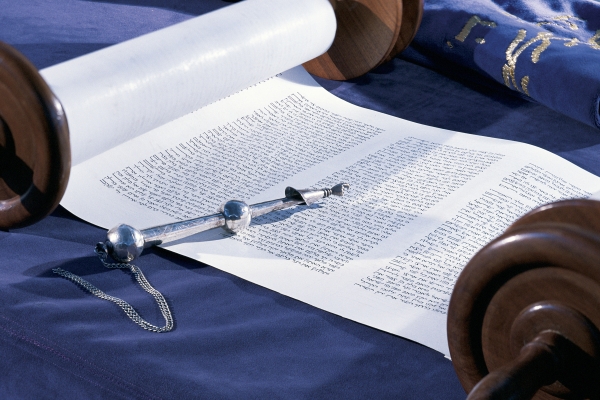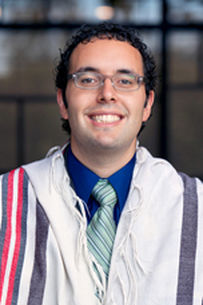 Our double portion of B’har-B’chukotai opens with a tantalizingly simple statement: “The Eternal One spoke to Moses on Mount Sinai” (Lev. 25:1). This may not, yet, strike you as remarkable. God, after all, talks to Moses all the time, and no one contests (at least within the Torah itself) that some of that talking happened at Sinai. Still, why mention that now? Why, after the whole Book of Leviticus with all its many laws and details, does the Torah suddenly return us to Mount Sinai?
Our double portion of B’har-B’chukotai opens with a tantalizingly simple statement: “The Eternal One spoke to Moses on Mount Sinai” (Lev. 25:1). This may not, yet, strike you as remarkable. God, after all, talks to Moses all the time, and no one contests (at least within the Torah itself) that some of that talking happened at Sinai. Still, why mention that now? Why, after the whole Book of Leviticus with all its many laws and details, does the Torah suddenly return us to Mount Sinai?
Medieval commentator extraordinaire Rashi, responding to a possibly heretical idea, asserts that this phrase means precisely the opposite of what you might think. It would be natural to assume that because the Torah makes special mention that these specific things were said on Mount Sinai, other things weren’t. Maybe, for example, Moses got the general ideas of the mitzvot at Sinai but then worked out the details himself when he came down from the mountain. There are, after all, some mitzvot first given in Exodus or Leviticus that are reiterated with new and different details in Deuteronomy. Just maybe, a person might think, the Sinai moment wasn’t quite as complete as we would think. Not so insists Rashi! The Torah brings us back to Sinai in this verse precisely to insist that “every Divine command that was spoken to Moses came from Sinai, including both general principles and minute details” (Rashi on Lev 25:1).
Returning to Sinai, according to Rashi’s teaching, means to dig into the details of Jewish text and law. As the COVID-19 pandemic was just beginning, the weekly Torah study group at my congregation took a deep look at the tradition of n’tilat yadayim, the ritual of handwashing. We learned halachic (legal) texts, midrashim, pieces from the Talmud, and contemporary sources, and created our own Sinai moment — connecting our 2020 ritual of 20-second handwashing to those principles and details revealed, at least according to Rashi, at the original Sinai.
Spanish commentator Ramban, who, as is his custom, restates Rashi’s points only to vehemently disagree with them, saying “and this seems entirely wrong in my eyes,” sees this moment differently. This is, he believes, just the next step in the story. Moses went up to Sinai, got the Torah, came down and dealt with the Golden Calf, in response to which the people needed to build the Tabernacle. Once they had the Tabernacle, they needed to learn how to use it, and those instructions ended with last week’s Torah portion. Now, at the beginning of this week’s portion, as we shift our focus away from sacrifices and look forward to our new lives in the Land of Israel, the Torah reminds us that these laws are just the next chapter of the Torah taught to Moses at Sinai. The important message is not about minute details and general principles — it is about the vital connection between the Sinai moment and these mitzvot that take effect only when we enter the Promised Land.
Returning to Sinai, according to Ramban’s teaching, means connecting our immediate story to the larger narratives of our people and our tradition. This year, at my very unusual Passover seders, as we gathered together with family and friends over Zoom, we considered that this was not the first time Jews have needed to adapt our Passover observance. We talked about Conversos in Spain, partisans in the Warsaw Ghetto, the Jews sheltering within their homes during the 10th plague, and we made a Sinai moment as we took our place in the story of our people stretching back to the original Exodus thousands of years ago.
The Talmud, in one of its most incredible stories, offers yet another vision of the Sinai moment. In Tractate M’nachot 29b we learn that, according to Rav, while Moses was on Mount Sinai he took a magical journey forward in time to the yeshiva of Rabbi Akiba. Sitting in the back row while the great Akiba taught, Moses was utterly confused. His spirit fell as the arguments spun around in circles he just couldn’t follow. One of the other students raised a hand and asked “Rabbi, where in the Torah did you learn this?” Akiba answered: Halachah l’Moshe MiSinai, “This law was given to Moses at Sinai.” Then Moses’ mind was set at ease. His own Torah, he understood, was so much larger than even he himself could understand.
Returning to Sinai, according to Rav’s teaching, means seeing ourselves as embodying Torah that looks forward at generations to come. My Grandma Elaine, of blessed memory, taught me many things — none of which she would consider to be of religious import. Perhaps the most Jewish person I’ve ever known, she asserted that her own Judaism was “Epicurean” in nature, which mostly meant that she loved Jewish food and music. My own Jewish life, defined by observance, study, and prayer, would be an absolute mystery to her — and yet I see her in just about everything I do. Like Moses, she didn’t know where her Torah was going, but its power and depth have grown long after her passing. When I imagine my own future grandchildren, I think of Moses at Akiba’s yeshiva, and I am moved as I return to Sinai.
That original Sinai moment back in the Book of Exodus, when true inspiration — surprising, unpredictable, and unquestionably Divine — suddenly descended upon the world, is by its very nature mythical. Biblical scholarship and historical inquiry aside, Moses’ receiving Torah at Sinai is a basic tenet of our faith that we pass on from generation to generation. It is one of those fundamental beliefs that we love to struggle with.
To return to Sinai is to acknowledge that there are real moments of Revelation. To return to Sinai is to admit that we don’t have all the answers. To return to Sinai is to let go of our rationalist selves and open ourselves up to higher truth. It is simultaneously the simplest idea to understand and the hardest concept to swallow.
As we face a world unlike any we have ever known, and the challenges ahead seem terrifying, the pathways leading up the mountain towards Revelation and inspiration are even more important for us to follow. In this moment it is our hearts, not our heads, which hold the answers. Sometimes, like Rashi, digging into details of observance and practice transports us to something bigger than ourselves. Sometimes, like Ramban, our spirits will be elevated by choosing to see our own present as a sacred reflection of our people’s past. And sometimes, like Moses standing beside Akiba, the experience that lifts us towards an unknown yet hopeful future is the act of standing beside the generations yet to come, and imagining what they might need from us now.
The Book of Leviticus, which we finish this week, closes the same way our portion begins. “These are the commandments that the Eternal gave Moses for the Israelite people on Mount Sinai” (Lev. 27:34). Revelation, inspiration far beyond human understanding, was given to us at Sinai, and so when logic fails and the heart is left wanting, it is to Sinai that we must return.
 When I lived in the United States, I found it difficult to relate to the double Torah portion we read this week, B’har-B’chukotai. B’har focuses exclusively on the laws of Sh’mitah — the Sabbatical year when the Land of Israel lies fallow — and the yovel, or Jubilee year, when all debts were to be released and land was to return to its original owner. B’chukotai deals with reward and punishment for observing the commandments; and values assigned to different categories of people if they make a vow to donate to the portable Tabernacle and, later, the Temple in Jerusalem. At first glance, these can be very difficult Torah portions to connect with because of the geographic, theological, and ethical challenges they present.
When I lived in the United States, I found it difficult to relate to the double Torah portion we read this week, B’har-B’chukotai. B’har focuses exclusively on the laws of Sh’mitah — the Sabbatical year when the Land of Israel lies fallow — and the yovel, or Jubilee year, when all debts were to be released and land was to return to its original owner. B’chukotai deals with reward and punishment for observing the commandments; and values assigned to different categories of people if they make a vow to donate to the portable Tabernacle and, later, the Temple in Jerusalem. At first glance, these can be very difficult Torah portions to connect with because of the geographic, theological, and ethical challenges they present.
Like everything in Torah, however, first glances lead to second and third glances. We dig deeper, leading to discovery of additional layers of meaning, connection, and application to our own lives. This is what Pirkei Avot, “Ethics of our Ancestors,” tries to tell us in the teaching of a Sage named Ben Bag Bag:
"Turn it (Torah), and turn it, for everything is in it. Reflect on it and grow old and gray with it. … " (Pirkei Avot Chapter 5, Mishna 22)
This is especially true of this week’s double Torah portion. When our first glance gives way to broader and deeper perspectives, we can find meaning in — and current application for — all three major themes: the Sabbatical year; reward and punishment; and valuations.
Sh’mitah, the Sabbatical year: For most of world Jewry, the laws of the Sabbatical year do not apply. These are commandments that are only observed in the Land of Israel, which begins the next Sabbatical year in September 2021. Here in Israel, these laws raise very practical questions with major implications on our lives:
- Must all agricultural industry stop in the seventh year?
- If we sell the land in the same way we sell our chameitz, “leaven,” on Passover, are we permitted to work the land?
- Do we have to import our fruits and vegetables?
The livelihoods of thousands of Israeli citizens depend on how these questions are answered. Because there is no separation of religion and state in Israel, the laws impact farmers regardless of whether they are religious or secular.
At the same time, planning for the arrival of the Sabbatical year in Israel can also be the basis for serious discussion about how we can be better stewards of nature and land throughout the world. As the impact of global warming grows, such conversations, and subsequent actions, are more important than ever.
Reward and punishment: In Leviticus 26, B’chukotai takes a literal approach to the observance of commandments and prescribes the rewards and punishments God will mete out depending on how we act. Similar to the way the toch’chah (rebuke) is presented in Deuteronomy 28, a very short list of blessings as rewards for following the commandments is followed by a lengthy articulation of terrible punishments we will receive as individuals and as a nation for failing to observe. God is portrayed as looking down from above, keeping track of our behaviors, and giving us carrots and sticks depending on what we do.
Moving away from the difficult construct of the punitive God, there are clear life lessons that we should take away from these passages. Where choices and behaviors are concerned, we know that Newton’s third law is right: For every action, there is an equal and opposite reaction. The choices we make have consequences, for ourselves and others, as we have seen all too painfully in the days of COVID-19. B’chukotai invites us to have serious discussions with our families about choices and consequences, values and their impact on others and on the world.
Valuation: The second half of the B’chukotai deals with how to determine the cost of a vow that a person makes if they pledge to donate to the Tabernacle and, later, the Temple in Jerusalem. This is a literal exposition of the question, “What is a person worth?” The Torah assigns different values for the cost of the vow based on gender, age, and so on. In our society, just hearing that values are assigned based on these categories can cause the hair on the back of our necks to rise! Yet, it is clear that in our modern society, we have not yet succeeded in changing the parameters of this conversation. We see it in the wage gap between men and women, in the way some people seem to value celebrities more than their own neighbors.
The global pandemic has brought the issue of valuing human life into sharper focus. On one hand, heroic medical professionals in overcrowded hospitals are being forced to make the most difficult choices about how to treat people infected with coronavirus. They are having to decide which patients will get the precious, and very limited, medical resources that may help save their lives and which will not. At the same time, it is shocking to hear statements on the news, social media platforms, and even from friends who callously declare that whole categories of people, seniors and those with medical issues, should either be the lowest priority or should not get care at all. The way Torah presents valuation at different levels should be an opportunity for serious discussion about the importance of valuing every human life as precious and deserving of treatment.
This Shabbat, we stand for the last verse of B’chukotai and proclaim: Chazak, chazak, v’nitchazeik, “Be Strong, be Strong, and together, we will be strengthened”!
Through serious discussion of even the most seemingly esoteric and difficult passages of Torah, we can all discover new connections, new meanings, and new applications to our daily lives. In so doing, we increase our sensitivity to others, make our choices in more intentional and thoughtful ways, and see the Divine spark and inherent value in every person. When we do that, the entire world is strengthened.
B’har/B’chukotai, Leviticus 25:1-27:34
The Torah: A Modern Commentary, pp. 940-970; Revised Edition, pp. 849-879
The Torah: A Women’s Commentary, pp. 747-786
Haftarah, Jeremiah 16:19-17:14
The Torah: A Modern Commentary, pp. 1,006-1,008; Revised Edition, pp. 880-882
Explore Jewish Life and Get Inspired
Subscribe for Emails


